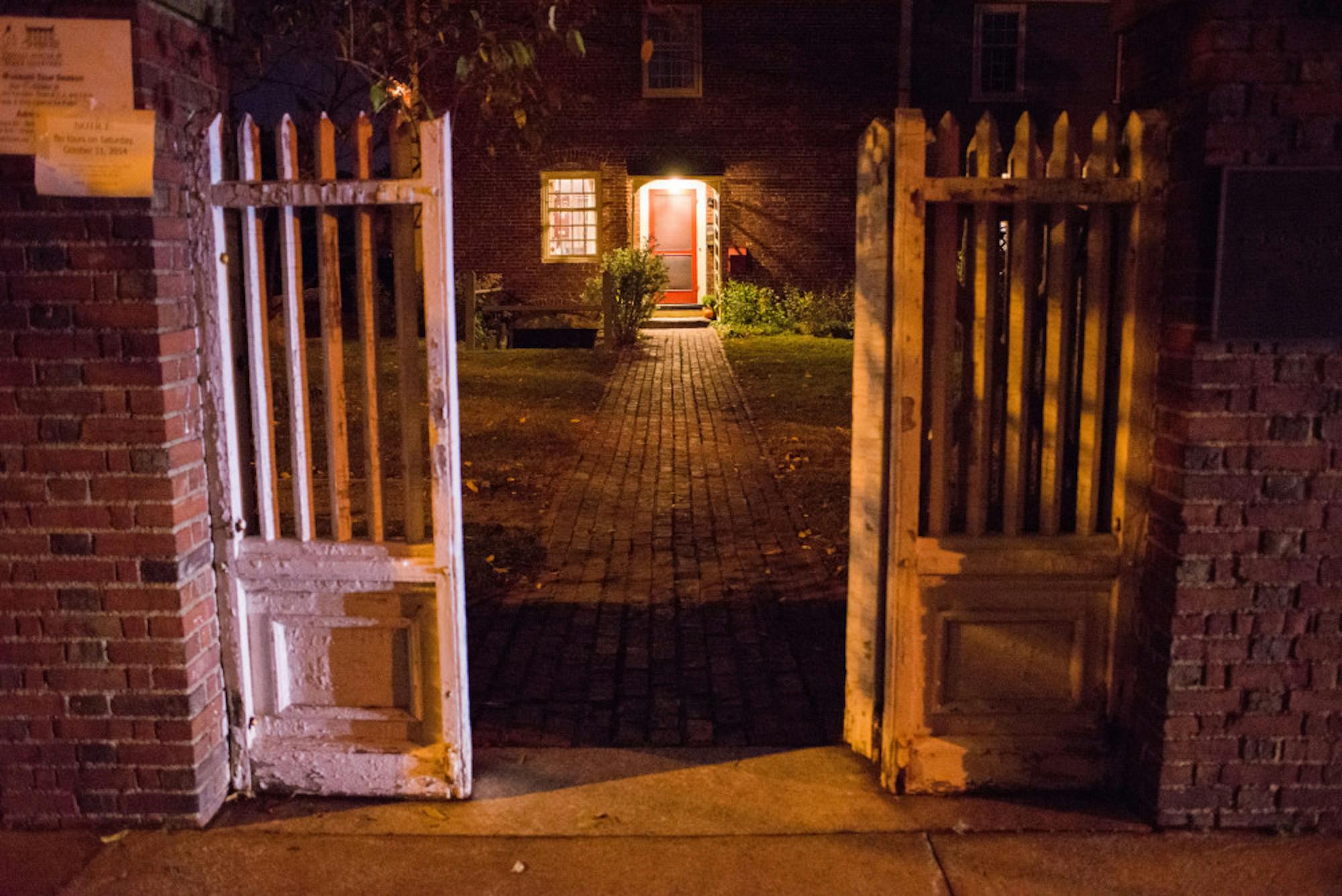The Tufts/Medford Black Freedom Trail, connecting on-campus sites including the Capen House, the Lena D. Bruce (E ’92) and Anita Y. Griffey (LA ’89) Bench and Goddard Chapel Plaque, signifies the stories and moments in the African American history at Tufts.
According to Professor of Political Science Pearl Robinson, who has taught at Tufts since 1975, the Tufts/Medford Black Freedom Trail serves as a means to not only document, but to physically mark the Black presence at Tufts as an integral part of the Tufts landscape.
The trail was the brainchild of late professor Gerald Gill (1948-2007), who taught African American history and worked extensively to document Black history at Tufts, including a comprehensive piece on the topic in Tufts's online magazine and a photo exhibit in the art gallery.
Robinson explained that the origin of the trail traces its roots to the Freedom Trail in Boston, which highlights important locations of the American Revolution.
“Some decades ago, people who were trying to record and document the history of African Americans in Boston created a black freedom trail,” she said. “One of the things Gill used to do…would be to take his students into Boston and arrange for them to have a tour … Somehow along the way he got it in his mind that there was enough history of the presence of blacks on the Tufts campus to do a similar project.”
Sadly, Gill passed away before he could see his project complete.
“As far as I can tell, people didn’t know he was working on this trail or there was no official Tufts record,” Robinson said. “I’ve been saying for a decade, the trail should be done, it should be appropriately marked, and when done that way… it makes the Black presence at Tufts a natural part of the landscape."
She cited several important effects of the trail, such as that it would establish that Black students attended Tufts long before the implementation of Affirmative Action or Diversity policies and that it connects the Black presence at Tufts to the ongoing Freedom Struggle in the United States.
Last fall, the idea was taken into action at the "Social Movements and the Black Intellectual Tradition — An Africana Symposium" on Nov. 20, 2015.
“With support of Africana Studies,the Center for the Study of Race and Democracy (CSRD) and the Africana Center, several Tufts faculty, students and staff (including Robinson, Africana Center Director Katrina Moore, [Professor of English] Modhumita Roy and [Professor of History] Kendra Field) began to reconstruct this trail,” Kendra Field, Center for the Study of Race and Democracy interim director, told the Daily in an email.
“Alongside a number of returning Tufts alumni, including Leslie Brown (LA '77), Seth Markle (LA '00), Zachariah Mampilly (LA '99),Christina Greer (LA '99), Emory Wright (LA '00) and Zerlina Maxwell (LA '03), we re-traced key on-campus sites as part of a memorial walking tour,” she wrote.
In addition to the three locations mentioned above, the on-campus memorial walk included the Africana Memorial Tree and Planar Mountain, sculpted by Richard Hunt in dedication to T.J. Anderson, a retired Tufts Austin Fletcher Professor of Music Emeritus. The sculpture, which once stood in front of Carmichael Hall, can now be found at the Remis Sculpture Court. Other sites included the Lena D. Bruce and Anita Y. Griffey Bench and Carpenter House, which served as the Afro-American Cultural Center in the 1970s.
According to Robinson, the list is incomplete. One site not included is Lewis Hall, where students and Professor of History Daniel Mulholland protested the construction of the building, since the university hired contractors that did not incorporate equal opportunity initiatives into their hiring processes, according to a Nov. 19, 2014 Daily article.
“When we go about the process of fully documenting the sites… that protest, and even the article Mulholland and what he would say — captions of oral history would be in that,” Robinson said. “Part of this was like an oral history project or documenting history project that still has work to be done to capture it.”
Additionally, prior to the 2016 Africana Distinguished Lecture on Feb. 11, a community bus toured off-campus sites, according to Field. These included the Royall House and Slave Quarters, the Stearns “Secret Six” marker connected to abolitionist John Brown and the historic African American community of West Medford.
“This mapping project aims to connect past and present research, teaching, public projects, and collective memories of Tufts faculty, alumni, staff, students and community members, in relation to four centuries of African American history in Medford,” Field wrote. “The project aims to support historical memory and inter-generational community within and beyond Tufts.”
According to a Feb. 10 Boston Globe article,Black families settled in West Medford between the Civil War and the early 1990s, establishing a vibrant African-American neighborhood. Built on self-sufficiency, Shiloh Baptist Church was founded, and a surplus Army Barracks was converted into the West Medford Community Center, the main setting for social activity. The social tide began to shift in the 1980s, when violence was on the rise in neighboring cities, and an influx of whites settled into the area, driving home prices up.
Part of the significance of the Tufts Black Freedom Trail is that it documents a community history that dates back to the era of slavery, Robinson explained.
"Ebony and Ivy: Race, Slavery and the Troubled History of America’s Universities," written by Craig Steven Wilder, featured at this year’s Africana Distinguished Lecture, explores the relationship between slavery and the rise of higher education, maintaining that it is “the third pillar of a civilization based on bondage.”
In 1737, the Royalls, with 27 black slaves, built an estate in Medford on the site of the original grant of Governor John Winthrop. Today, a portion of Tufts sits on that land, Ten Hills Farm. Peter Gittleman, co-president of the Royall House Assocation, provided insight to this history.
“Tufts and the Royalls’ estate shared a piece of land on the east side of College Ave. across from the gym,” he wrote in an email to the Daily. “In the 18th century, Ten Hills Farm was a 500-plus acre working farm that was home to the largest slaveholding family in Massachusetts. It was also home to the many enslaved Africans who worked on the farm and in the house.”
Gittleman explained that there is a balance that must be maintained in preserving the house.
“Even though much of the surviving estate seems to only show the lavish lifestyle of the Royall family, we try to present the site from a balanced perspective, not only discussing the wealthy land owners but just as importantly, we discuss the enslaved people who toiled to make the estate function,” he wrote. “We hope visitors walk away with a deeper understanding of slavery in the North. So many people think of slavery as a southern issue, but in the 18th century, slavery was quite common in the northern states. The Royalls’ were certainly on an unusually large scale… but many New Englanders were involved in some aspect of slavery."
This local history is often unknown to Tufts students. Robinson explained that she sees the trail as “a tremendous opportunity for a hands-on learning experience” to deepen and enrich Tufts history.
Robinson stressed the importance of physically marking the sites of the tour.
“In a way, what marking the trail would do, is it’s a way of memorializing the way in which Gill taught African American history," she said. "Almost everybody took his Introduction to African American History … survey course. It didn’t matter what you were majoring in … It became kind of a hallmark of what a Tufts education is. Some basic knowledge of African American history.”
Robinson said Gill had contributed immensely in connecting students with this part of the history.
“He had a way of making every student feel like that history was part of their lives — [you had to go and] get the newspaper of the day you were born and see what was going on in the world at that point," Robinson said. "And if you looked for something that’s going on that has… some evidence of anything that’s happening with African American history or was happening in America… you see that you as an individual are connected to a larger history."
Black Freedom Trail marks important locations, retells stories of black history

The Slave Quarters at the Royall House in Medford is pictured on Oct. 10, 2014.





